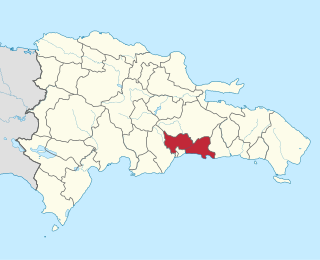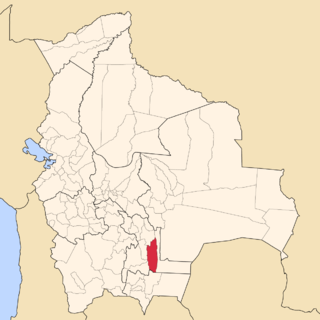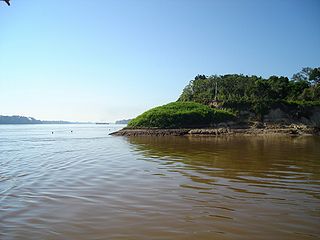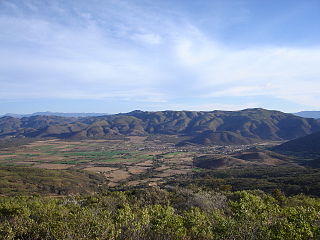
Santo Domingo is a province of the Dominican Republic. It was split from the Distrito Nacional on October 16, 2001.

Caranavi Province is one of the twenty provinces of the Bolivian La Paz Department and is situated in the department's eastern parts. The province was created by Law 1401 on 16 December 1992 from a portion of what was then Nor Yungas Province. The creation of the province had been a local cause embraced by Ramiro Revuelta, a Deputy in the national legislature who was assassinated on November 28, 1992.

Hernando Siles is a province of the department of Chuquisaca, Bolivia. In the 2001 census it had a population of 36,511. It covers an area of 5,473 km², giving it a population density of 6.67/km². Its capital is Monteagudo.

Azurduy Province is a province in the Chuquisaca Department in Bolivia. Its seat is the town of Azurduy. It was named in honor of revolutionary guerrilla Juana Azurduy de Padilla. In the 2012 census it had a population of 24,855.

Tomina is the seat of the homonymous municipality located in the Tomina Province in the Chuquisaca Department of Bolivia. At the time of the 2001 census it had 983 inhabitants.
Yamparáez is the seat of Yamparáez Municipality located in the Yamparáez Province in the Chuquisaca Department of Bolivia. At the time of census 2001 it had 903 inhabitants.

Costa Rica is administratively divided into seven provinces which are subdivided into 84 cantons, and these are further subdivided into districts. Cantons are the only administrative division in Costa Rica that possess local government in the form of municipalities. Each municipality has its own mayor and several representatives, all of them chosen via municipal elections every four years.

Federico Román is one of the five provinces of the Bolivian department of Pando and is situated in the department's northeastern parts. Its name honours General Federico Román.

Obispo Santistevan is one of the fifteen provinces of the Bolivian Santa Cruz department and is situated in the department's western parts. The province was founded on 2 December 1941, and its name honors Obispo Santistevan (1843–1931), famous supporter of the building of Santa Cruz Cathedral.

Ñuflo de Chávez is one of the fifteen provinces of the Bolivian Santa Cruz Department and is situated in the northern and central parts of the department. The name of the province honors the conquistador Ñuflo de Chaves (1518–1556) who founded the city of Santa Cruz de la Sierra. Its capital is Concepción. The province was created by law of September 16, 1915, during the presidency of Ismael Montes. Originally it was part of the Chiquitos Province.

Manuel María Caballero Province is one of the fifteen provinces of the Bolivian Santa Cruz Department and is situated in the department's western parts. The province name honors deputy Manuel María Caballero from Vallegrande, one of the signatories of the Bolivian constitution of 5 August 1861.

The Parapetí River is a river in Bolivia that has its source on the eastern side the Andes, flows through the Gran Chaco of Bolivia and ends in the marshes of the Bañados de Izozog depression. The drainage basin is 25,300 km2, and with the inclusion of the Bañados of Izozog is 61,903 km2.
Arbieto Municipality is the third municipal section of the Esteban Arce Province in the Cochabamba Department, Bolivia. Its seat is Arbieto. At the time of census 2001 the municipality had 9,438 inhabitants.

Sacabamba Municipality is the fourth municipal section of the Esteban Arce Province in the Cochabamba Department, Bolivia. Its seat is Sacabamba. At the time of census 2001 the municipality had 4,718 inhabitants.
San Benito Municipality or Villa José Quintín Mendoza Municipality is the third municipal section of the Punata Province in the Cochabamba Department, Bolivia. Its seat is San Benito. At the time of census 2001 the municipality had 12,720 inhabitants.

Arani Municipality is the first municipal section of the Arani Province in the Cochabamba Department, Bolivia. Its seat is Arani. At the time of census 2001, the municipality had 11,542 inhabitants.
Sipe Sipe is a location in the Cochabamba Department in central Bolivia. It is the seat of the Sipe Sipe Municipality, the second municipal section of the Quillacollo Province.
Villa Serrano is a small town in the Chuquisaca Department, Bolivia. It is the seat of the Belisario Boeto Province. At the time of census 2001 it had 2,877 inhabitants.
San Pedro de Quemes is one of the cantons of the San Pedro de Quemes Municipality, the second municipal section of the Nor Lípez Province in the Potosí Department of Bolivia. During the census of 2001 it had 574 inhabitants. Its seat is San Pedro de Quemes with a population of 490 in 2001.
Villa Orias (Tarvita) is a town and administrative centre in Tarvita Municipality, Azurduy Province, Chuquisaca Department of Bolivia. It is in the Cordillera Oriental of the Andes, where the Puca Mayu River and the Cruz Mayu River meet to form the Tarvita River.















